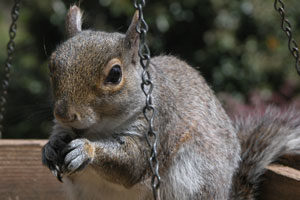Vol. 2 Issue 3, Fall 1997
By Ann Hocker

Gray Squirrel
Photo by Nicole Sudduth
One of the pastimes my husband and I enjoy with autumn approaching is listening to football games. However, that doesn’t necessarily apply to the squirrel version, which includes late night rowdy soccer in our attic. Although my tolerance level is much higher than many folks’, I am blessed with a home surrounded by woods, including many storm-caused snags that we graciously leave for housing for our wild friends. They may not include central heating, but that’s why nature has given them living fur coats.
The time to button up your home and think about encouraging your chimney and attic residents to leave is early fall, when most of their child-rearing duties are over and the food and shelter options are high. Although there may be some over-fertile stragglers, specially tree squirrels and raccoons, who have late litters, the majority of wild creatures are old enough to engage in what we call the “fall shuffle,” when the young leave the nest and begin lives on their own.
One of the first things you should have is a chimney cap. This is not to be confused with the terminology used by chimney builders, as I found out the hard way after being assured by our builder that he had installed a cap. This is a device that fastens to the top of your chimney, made of wire mesh with a raised “roof”, which will keep out unwanted guests. A good chimney-cleaning service will not only check your chimney for residents but also sell and install the device. You may also buy one at a hardware store and install it yourself, if you like climbing around on roofs, which I do not. This is an essential piece of household equipment, regardless of where you live, and will give you peace of mind come spring, when wildlife house-hunters get into full swing.
In older houses, and even some new ones, there are often numerous ways to enter the attic from outside, but before you start plugging, make sure no animals are already living there. Pieces of hardware cloth, screening, and a good staple gun are the best tools for excluding nocturnal creatures like bats. You must give them a way to exit in the evening, and then no way to get back in. This entails tacking on a one-way door, or check-valve, made of screen or netting that drapes over and below the main entrance. The idea is that bats will crawl down and out, but be unable to find their way back in. To find the hole, look for a discolored area from their body oils as they enter and exit, but remember there is generally more than one cavity that they will use.
Keep this in place for several days and perhaps move it to other locations not yet secured with hardware cloth. Before you do the final sealing, do a flashlight check of your attic to check for holdouts; look for fecal stains on the walls or floor below the roost. Also check the one-way doors every morning to make sure no creatures are tangled in it. Screen the inside of your attic vent louvers. I’m not well versed on insects, but would think this prevention would also apply to wasps and hornets. For more information on bats, contact Bat Conservation International (BCI) at P.O. Box 162603, Austin, TX 78716 (800) 538-2287 ( www.batcon.org).
Screen off the dryer vents with hardware cloth to discourage starling nests. Clean accumulated lint as necessary to avoid problems.
Raccoons are fun-loving creatures, especially if the fun is at the expense of your garbage, compost piles, or pet food. First, don’t leave pet food outside; this invites any number of creatures to sample your buffet. You can’t blame raccoons, foxes, skunks or opossums for taking advantage of a free meal. Feed your pets inside or bring the food in at night. Most animals scavenging a compost pile are after meat products; don’t put any in there. Garbage cans can be secured with strong bungee cords; I prefer the black rubber kind.
Visitors can come in pet doors, so these should be secured at night. If you surprise an unauthorized party going on in your kitchen (assuming the pet door is there), don’t panic, but move very slowly to close off access to the rest of the house. If the critters haven’t left yet, try to open the kitchen door from the outside. If this doesn’t work, call Animal Control, and don’t be a hero. An animal that feels trapped or threatened will behave unpredictably and often violently.
Beavers can be frustrated by various devices, depending on what you are trying to protect. A wire cylinder, preferably heavy 2×2 inch welded mesh, can encircle most trees (leave space to grow) with mulch between the wire and the tree to discourage weeds. Use smaller mesh if your problem is mice and similar rodents. For small trees, corrugated plastic drain pipes with slits for growth will serve. To regulate water level in ponds, several types of “ beaver bafflers” will allow water to flow and discourage beavers from plugging them.
I haven’t covered all possible situations, but I hope you can utilize some information here that will make you happy to see your wild neighbors and give you a night’s sleep without listening to fussball in your attic!

